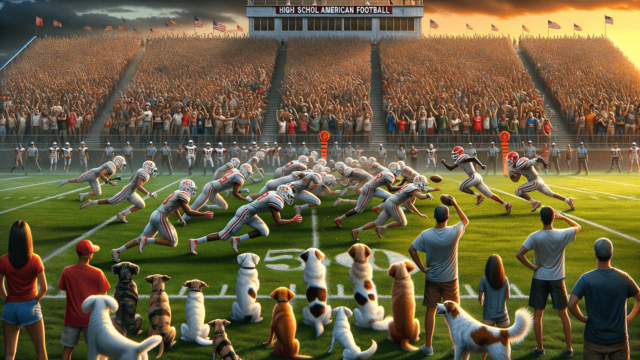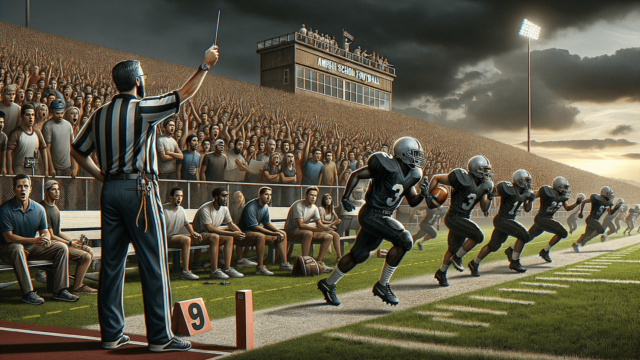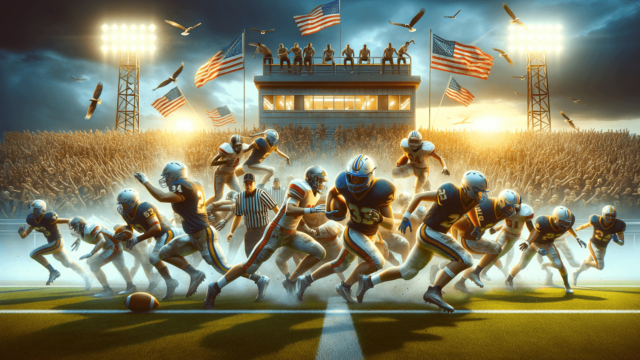
In high school football, hurdling is generally not allowed. The NFHS (National Federation of State High School Associations) rulebook states that a player cannot jump, dive, or hurdle over an opponent, with limited exceptions when there is no contact. Consult your region’s specific rules for any variations.
Understanding Hurdling in High School Football
In high school football, there are rules surrounding the act of hurdling, which refers to an offensive player attempting to jump over a defensive player while in possession of the ball. Here, we’ll explore the rules and regulations regarding hurdling and explain certain exceptions.
NFHS Rules on Hurdling
The National Federation of State High School Associations (NFHS) explicitly prohibits hurdling in high school football. According to Rule 2-22, players are not allowed to jump, dive, or hurdle over an opposing player, with a few limited exceptions.
Exceptions to the Hurdling Rule
While hurdling is generally not allowed, there are exceptions outlined by the NFHS. These include instances where:
- There is no physical contact between the hurdling player and the opponent,
- The hurdling player is avoiding contact and not using the act of hurdling to gain an unfair advantage, and
- The opponent is on the ground during the course of play and the ball carrier is avoiding contact with them.
Consequences of Illegal Hurdling
When players engage in illegal hurdling in high school football, they face penalties such as:
- A loss of ten yards from the spot the foul occurred,
- An automatic first down for the defensive team, and
- Potential disqualification if the act is deemed to be unsportsmanlike conduct.
Regional Variations on Hurdling Rules
While the NFHS offers a standard set of rules that most high school football leagues follow, it’s important to keep in mind that regional variations can exist. It’s crucial for players, coaches, and parents to consult their specific region’s rulebook to understand any rule variations regarding hurdling in high school football.
The Origins of Hurdling in Football
The practice of hurdling has been a part of American football since its early days, likely inspired by track and field events like the 110-meter high hurdles. Hurdling was once a more common tactic on the gridiron, particularly in offensive play, when players would literally jump over defenders to advance the ball. However, due to the increased risk of injuries in modern football, hurdling has faced tighter regulations, especially in high school football.
Injuries Related to Hurdling
One of the main reasons hurdling is discouraged in high school football is to prevent injuries. When a player attempts to hurdle, both the ball carrier and the defensive player may be at greater risk of injury. For the ball carrier, failing to clear the defender can lead to falling awkwardly, risking injury to the head, neck, or legs. In addition, the defender may also be vulnerable to injuries due to unexpected collisions or falls.
How to Counter a Hurdling Opponent
While hurdling is not allowed in high school football, it is still important for players to know what to do if they encounter a hurdling opponent. Here are a few strategies to counter hurdling and minimize risk:
- Keep a low center of gravity with a strong base of support – This makes it harder for the offensive player to leap over a defensive player.
- Be prepared to move laterally – A quick side-step can impede the hurdling player’s forward progress, potentially forcing them to land awkwardly or lose their balance.
- Go for the legs – If a player attempts to hurdle, they will be more vulnerable to lower-body tackles, limiting their ability to evade defenders.
Alternative Techniques for Avoiding Tackles
Instead of hurdling, high school football players can choose alternative, safer methods to avoid tackles. These techniques can be just as effective and fit well within the rules of the game:
- The stiff-arm – Using an outstretched arm to push away a tackler can create space for the ball carrier to move past without attempting to leap over a defender.
- Changing direction – Cutting back and forth can confuse defenders and create opportunities to break free of tackles.
- The spin move – This technique allows the ball carrier to move around a defender while keeping their feet on the ground and hands firmly on the ball. Additionally, spinning can be difficult for defenders to counter, thus creating separation and elastic movements to gain extra yardage.
FAQ Section: Hurdling in High School Football
After reading about hurdling in high school football, readers may have additional related questions. In this FAQ section, we’ve compiled some common questions and provided concise, direct answers.
Why is hurdling dangerous in high school football?
Hurdling is considered dangerous in high school football because it significantly increases the risk of injury for both the ball carrier and the defensive player involved. When hurdling, players can fall awkwardly, leading to injuries to their head, neck, legs, or other body parts.
Are there any instances where hurdling is allowed in college or professional football?
In college and professional football, hurdling is more commonly allowed, but specific rules vary depending on the league or level of play. Most professional leagues permit hurdling as long as the player does not initiate forcible contact with an opponent.
How can a defensive player reduce the risk of injury if an offensive player attempts to hurdle?
Defensive players can reduce the risk of injury by maintaining a low center of gravity with a strong base, moving laterally to impede the hurdling player’s progress, and focusing on lower-body tackles to limit the hurdler’s ability to evade them.
If hurdling is not an option, what are some effective running techniques for eluding tacklers?
Some alternative techniques to hurdling include using a stiff-arm to push away tacklers, changing direction to confuse defenders, and employing a spin move to evade defenders while keeping feet on the ground and maintaining control of the ball.
Can a high school football player be disqualified for hurdling?
Yes, a high school football player can be disqualified for hurdling if the act is deemed unsportsmanlike conduct. Other penalties may include a loss of yardage and an automatic first down for the defensive team.
Featured Posts
- No pillar pages found.





